
Working Womens' Dress in 16th Century Flanders
excerpted from my book The Well-Dress'd Peasant: 16th Century Workingwoman's Dress
By Drea Leed
 If you are interested in constructing an Flemish woman's ensemble based on the information in this paper, check out Constructing a 16th Century Flemish Ensemble.
If you are interested in constructing an Flemish woman's ensemble based on the information in this paper, check out Constructing a 16th Century Flemish Ensemble.

This paper is a result of a simple question: what did a working woman wear during the latter half of the 16th century?
I began my research under the impression that I would quickly find an answer--after all, the dress of 16th century is a popular subject among costume historians. English dress in particular has been well-researched, and I expected to find what I needed in such landmark publications as Janet Arnold's Patterns of Fashion: The Cut and Construction of Men & Women's Dress 1560-1620, and her renowned Queen Elizabeth's Wardrobe Unlock'd. In addition, the century is recent enough archeologically that a substantial amount of material evidence still exists for first-hand perusal, and the rising popularity of portrait painting during the reign of King Henry the VIII and his successor Queen Elizabeth I provided a wealth of detailed artistic evidence to use in my search.
I soon discovered, however, that my task would be more difficult than I'd imagined. Most books and articles on later 16th century dress focus primarily on the costume of the wealthy, for the simple reason that virtually all material and iconographical evidence from the time period relates to the clothing of the rich merchant class, nobility and royalty of the time. Few cooks or servants could afford to have their likeness painted; pictures and paintings showing the dress of poorer folk are relatively rare in comparison to the plethora of upper-class portraits painted during the 1500s. The poor didn't wear valuable clothing that would be preserved by future generations; neither did they receive the careful burial that has helped to preserve bodies and burial clothes until a 20th century historian came around to exhume and examine them.
As a result, information on the dress of the laboring class was scanty, general and relatively vague in nature. What I did find was composed mostly of secondary sources in conjunction with a great deal of speculation to make up for the scarcity of available material or pictorial evidence.
I eventually turned towards the art of the time in an attempt to see and hopefully work out for myself what I wanted to know, and after searching through several books and museum catalogs, discovered that resources were not as scarce as I'd expected.

Although virtually no portraits of lower-class women were to be found, the genre paintings popular in 16th century Flanders provided an unexpected bounty of material--images of market women, poultry vendors, kitchen maids, cooks and servants of the 1550s and 1560s, painted in delightfully realistic detail by artists such as Pieter Aertsen and Joachim Beuckelaer.
By using many of these paintings in conjunction with other 16th century written, pictorial and material resources, it is possible to create a reasonably accurate picture of what a kitchen maid or vegetable seller of the period would wear; and although I started out trying to research English lower-class clothing, these artistic sources changed the focus of my research to Flanders.
As most costume historians know, using contemporary art as a resource for reconstructing contemporary dress has its pitfalls; one must take into account the purpose of the painting, prevailing artistic styles of the time, the amount of realism or fantasy included in the painting, and any possible inaccuracies that both centuries of aging as well as painting restoration may have introduced into the painting's coloration and detail.
Fortunately, the people of interest in Aertsen and Beuckelaer's paintings--namely, lower-class marketwomen and servants--are not religious personages, and are therefore less likely to be portrayed in "symbolic" garments rather than everyday dress. Realism was in vogue in Flemish genre paintings of the time, which allows us to place more faith in the veracity of the costume depicted than in, say, pictures of biblical characters or classical allegories. In addition, comparison of several paintings by two artists of the same nationality, painted during the same time period and in the same general location, helps to eliminate other artistic variables which can result in inaccurate conclusions regarding the dress of the time.

It is often
hard to relate
artistic portrayals of dress to the concrete items worn, especially when none exist for comparison. In many paintings, unseemly wrinkles and seams are discreetly omitted, which can make the task of reconstructing the actual fit and look of the garments that much harder. To this end, I supplemented my research with hands-on experimentation, attempting to physically reconstruct the garments depicted in the paintings. Not only did this point out several potential areas in which the artists may have "flattered" their subjects, but it also resulted in several construction-related questions I would not have thought to ask had I contented myself with theoretical research. How were these garments finished and lined? How many layers or clothing were involved, and how did they interact? Why were these garments fastened and fitted as they were? How practical or impractical was this ensemble for the working women who wore it? Physically constructing and wearing these garments helped provide answers (or at the least reasonable guesses) at all of the above.
You see before you the results of this research--I am wearing an outfit similar, in as many respects as possible, to the everyday dress of a Flemish market woman of the mid-16th century. This, in conjunction with several slides of paintings by Beuckelaer and Aertsen, will serve as a visual aid to my description of the various items of dress which made up the "average" Flemish woman's ensemble.
In virtually all of the paintings examined, the dress worn by Flemish women from the 1550s to the 1570s is relatively homogenous in nature. There are several layers involved in the basic ensemble: linen smock, sleeveless kirtle, open-fronted gown laced up the front, and a partlet over the upper torso. Separate sleeves attached to the gown at the shoulders or bicep, or, in some cases, to the shoulder of the sleeveless kirtle worn under a short-sleeved gown. This 1565 painting by Pieter Aertsen gives a good depiction of all of these items mentioned.
Partlets
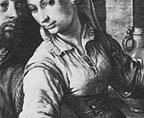
The topmost item is the partlet--an item of clothing worn over the upper torso in conjunction with low, square-necked kirtles and gowns. Although there is some variation in the neckline--some partlets are v-necked, others have a jewel neckline and still others have flared collars--it is invariably sleeveless, opens in front, and attaches under the arms. "Country Market" by Pieter Aertsen shows two women in the same scene wearing two differently designed v-necked partlets; although there are several depicted (all of which look like sheer linen), partlets with flared collars are more commonly seen.
The partlet is not a uniquely Flemish item of dress, although it is in Flemish paintings that it most often appears. This item had been in existence for several decades before Aertsen and Beuckelaer began painting--indeed, Hans Holbein the Younger depicted it in sketch of a court lady created in 1530. It was worn in England from the 1530s on. As you can see, the general shape of the partlet is the same.
The partlet construction and materials shown in the dozens of paintings of Aertsen and Beuckelaer are quite homogenous. They are always depicted as either of black fabric--presumably wool--with a high, fall-back collar (as in the "Gown" picure below), or of a sheerer white fabric, most likely linen. In many cases a black woolen partlet was worn in conjunction with a white under-partlet, cut in the same way and often with a small ruffle at the top. This combination can be seen in several of Aertsen and Beuckelaer's paintings; it is also the combination which I chose to wear today.
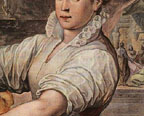
as the 1570s progress, Beuckelaer's paintings show the evolving shape of the Flemish partlet--the ruffle along the top edge of the fall-back collar has grown considerably, echoing the emerging popularity of the ruff, and is attached to a neck band rather than to the top edge of the partlet collar.

The clothing worn in conjunction with this item necessitated such protection--gown, kirtle and smock all had low, often square necklines. In this detailed picture you can actually see the neckline of kirtle and smock where they are revealed underneath the v-neck of the young woman's partlet.
This partial display occurs in several other portraits, and the respective necklines are easily seen through the sheerer linen partlets depicted in many paintings.
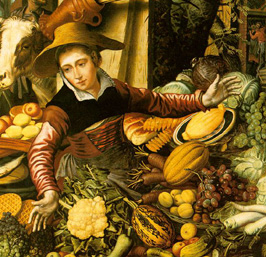
Gown
One of the signature aspects of mid 16th century lower-class Flemish dress--and one of the more eye-catching to modern viewers--is the open-fronted gown which laced closed across a kirtle or undergown. These gowns would have been woven of wool, the main fabric used by the lower classes and peasantry.
A number of variations on this gown are seen in the many pictures of Aertsen and Beuckelaer, but on the whole it, too, is a homogenous garment. It is either sleeveless, with wide-set straps hugging the outside of the shoulders, or has short capped sleeves reaching to the bicep.
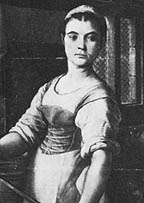
Eyes or metal rings of some kind were sewn to the front inner edges of this gown, through which a cord laced. In some paintings, as in the first picture shown, the neckline of the gown is quite high and matches that of the kirtle; in others, the neckline curves down to below the bust before the lacing begins. (see picture to the right). The sides of the gown can be as close as 3 inches apart, or leave most of the front of the body uncovered; it is very versatile when it comes to fitting a number of different shapes and sizes. In all cases it is only one lace which is used, zig-zagging from the top to the waist of the gown.

The sleeves attached to this gown, either with pins or a few stitches, were simple tubes with little shaping at the shoulders. They attached at the top of the shoulder strap or at the outside of a gown's capped sleeves, and in some cases attached to the gown at the back as well, as a painting of a man in Aertsen's "Old Peasant" painting shows. Some paintings show these flaring at the wrists and turned back to show a contrasting lining. In all likelihood the sleeves were, like the gowns they were attached to, made of wool.

Whether or not the front edges of this gown were boned is open to debate; Aertsen's depiction clearly shows a bodice under some strain at the front edges, which remain straight despite the slight puckers in the fabric. A painting by Beuckelaer shown to the right, on the other hand, depicts a similar gown with heavy wrinkling along the front edges. This gown is strapless and worn without sleeves or a black over-partlet; one historian of the time suggested that this was meant to symbolize a "loose" woman, or a woman in "disarray". In any event, she is clearly unsupported by anything more than layers of fabric.
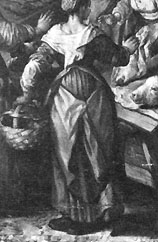
In the pictures where the waistline is shown--and there aren't many--the skirt attached to the gown by regular gathers, rather resembling large cartridge-pleats (or perhaps stuffed box-pleats) in the back. In some cases, the skirt front is open, as is the one I'm wearing; in other cases, the skirt has no center front opening and is presumably stitched to either side of the open-fronted bodice, with the center 6 to 10 inches of the skirt crossing between the two sides. This is at present simply speculation, however; the front waistline is, in almost all pictures, covered by an apron, most often white but sometimes red, olive green or other colors. No more than a rectangular piece of fabric, the corners were overlapped at the back of the waist or were connected by a band.

The outer fabric of the skirt invariably matches
that of the bodice it is attached to, but the lining is often a contrasting color--red, orange-gold, green, brown, or even, as is shown in two pictures, vertically striped. These skirts can be anywhere from foot-length to as high as mid-calf-- understandable for women to whom fire could be an occupational hazard and muck an everyday occurrence.

The skirt of the outer gown is subject to a number of treatments which keep it out of the dirt as well as show off the skirt lining and the kirtle. Several paintings by both Aertsen and Beuckelaer show the front bottom corners of the skirt drawn back and pinned together behind; some skirts with no front split are hitched up and tucked through the bottom lacing of the bodice, or hitched up behind. One painting of a marketplace by Beuckelaer showed a woman with the back and front of her skirt pinned together at the sides. There is a wide variety of skirt hitches, tucks and pinnings shown in these pictures, both front, back and sides.
Kirtle
The other main item of women's dress in later 16th century Flanders was the kirtle. It is something more of a mystery--indeed, the kirtle was one of the most polymorphous items of clothing to be found during the 16th century.

Examining the many paintings by Aertsen & Beuckelaer gave me clues as to a kirtle's shape--it had a low neckline, as mentioned before, which in some cases curved upwards in the middle. When visible, the straps are always sleeveless. It is unboned, and in some pictures appears almost loose enough to fit over the head while in others it appears quite smooth and tightly-fitted. One of Aertsen's paintings, shown to the left, shows a band of black trim across the top of the kirtle bodice. Wearing a close-fitting, sturdy linen kirtle provides enough support that heavy boning in the bodice is not necessary to create the flat and slightly elevated bosom so often seen in pictures of the 1550s in Flanders.

The only extant kirtle from the time period which we can look to for comparison is a German dress dating to 1580, depicted in Janet Arnold's Patterns of Fashion 1560-1620 (shown to the right). This item was a loose dress, lined in heavy linen, fitted at the shoulders and falling unfitted to a gored skirt. It had eyelets at the shoulders for laced sleeves, and a back closure which semi-fitted it to the body.
The neckline of the kirtle is substantially higher than those worn by Flemish workingwomen of the time, but in all other respects there is no way to conclusively prove, one way or the other, whether or not the kirtles worn in these paintings differed greatly from this example. Janet Arnold's research has led her to believe that kirtles of this time in England could also be close-fitted to the torso, and flared out from waist to the ankle. An item of dress fitting this description does appear in Flemish art, worn by a bourgeoise woman.
 Lacking more concrete evidence, this is what I chose to reconstruct when making my outfit--a low-necked, sleeveless dress with no waist seam, fitted to the waist and flaring from there to the ankle.
Lacking more concrete evidence, this is what I chose to reconstruct when making my outfit--a low-necked, sleeveless dress with no waist seam, fitted to the waist and flaring from there to the ankle.
Smock
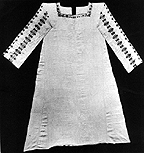 Linen smocks were worn by all women, not merely those lower down the food chain. Their purpose was a utilitarian one: they provided an easy-to-clean layer between the body and outer garments, protecting the less easily-washable wool gowns, kirtles & petticoats from sweat and body oils.
Linen smocks were worn by all women, not merely those lower down the food chain. Their purpose was a utilitarian one: they provided an easy-to-clean layer between the body and outer garments, protecting the less easily-washable wool gowns, kirtles & petticoats from sweat and body oils.
At most it is only the rounded square of the smock's neckline, and the straight, ungathered sleeves which are seen in Flemish paintings. These smocks were very likely similar in construction to the English smock shown here, dated to 1570, (slide of smock),: a simple gored dress with tube-shaped, gusseted sleeves and a flaring skirt. The women's' smocks would have been of white linen, as sheer as the wearer could afford. In some cases, the necklines were embroidered and embellished with simple black-threaded embroidery. Three smocks are so embroidered in these paintings, as is the neckline of one man's shirt.
Underpinnings
To many, the 1570s conjure up pictures of Elizabethan England: Spanish farthingales, boned corsets, "bumrolls" and all. The Spanish Farthingale (a hoop-shaped underskirt), boned corsets and boned bodices were indeed worn in Flanders during the 1560s and 1570s--but not by the lower class women portrayed in the genre paintings I studied. I could find no pictorial evidence that these servants, peasants and marketwomen wore any corseting or boned bodice underneath their garments, or for that matter, any boning at all aside from stiffening at the front edges of the gown. Nor, for that matter, did they appear to wear any hip-pads or bumrolls--stuffed crescents designed to enhance the swell of skirts around the hips as they fell to the ground.
Petticoats stiffened with horizontal channels filled by cording or twisted rags may have been worn, however. Such petticoats are mentioned in contemporary English accounts as worn by the middle and lower classes to enhance the size of their skirts, and a sketch of a Spanish woman does exist which shows her wearing such a garment; but there is no conclusive evidence, one way or the other, that they were worn with Flemish dress.

Hairdos & Headdresses
The hairdress, coifs, cauls and hats of these laboring women are the most varied aspect of their ensemble. Straw hats are worn in a number of paintings, a sensible form of headwear for marketwomen, vegetable sellers, and others who spent their days out of doors. The hats shown in Beuckelaer and Aertsen's paintings were shallow-crowned and wide-brimmed, similar in many respects to the basic shape of straw hats worn by women during the late 18th and early 19th century. Unlike the decorated bourgeoisie straw bonnets of Regency times, however, these straw hats appear to have been strictly lower class--they do not show up in pictures or portrayals of more affluent folk.
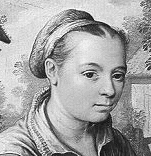
Another basic headdress, however, was worn by more affluent women as well as market vendors and serving maids: the caul, which was simply a circle of fabric gathered to a band. Beuckelaer's market woman shows this item in good detail. It appears to be made of fine linen, although similar cauls depicted in a bourgeoisie portraits show identical headwear constructed of black velvet or silk and extensively embroidered.
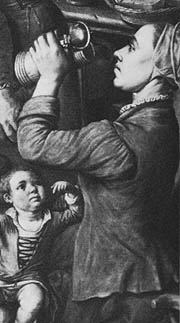
a fine linen veil with a wired front which came to a point in the middle front and arched out on either side to meet at the jaw. The Flemish hood was worn as far back as the 1520s in Flanders, when it consisted of a white veil, starched and creased down the middle, that pinned at the front corners to a coif of some kind worn underneath.
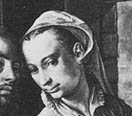
By the 1560s it had evolved into the more delicate and decorative item,
worn over the caul, shown in virtually all paintings of the later 1560s. This wired hood was also a multi-class fashion item; poor women as well as those more better off both wore them.
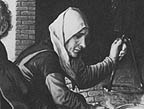 Older women are sometimes shown wearing a more traditional, unwired "flemish hood" reminiscent of those shown in the 1520s and 1530s.
Older women are sometimes shown wearing a more traditional, unwired "flemish hood" reminiscent of those shown in the 1520s and 1530s.
 A different veil arrangement--one which apparantly includes a wimple--is shown to the right, also worn by an older women. In all the paintings I examined, it was only clearly elderly women who were shown wearing this hairstyle.
A different veil arrangement--one which apparantly includes a wimple--is shown to the right, also worn by an older women. In all the paintings I examined, it was only clearly elderly women who were shown wearing this hairstyle.

In several of Aertsen's genre paintings painted during the 1560s, women do not cover their hair at all. Instead, it is wound with a ribbon and coiled around the back of the head. Aertsen's "Old Peasant" painting shows a girl wearing this hairstyle, with the addition of a cloth band wound around her head just in front of her coiled hair. Most interesting is the cotter-type pin shown, which slips through the band and through one twisted length of hair to fix it in place. This is the only painting to show such a fastening, although other examples of coiled hair show sections of hair pulled over the coils and fastened inside to secure them. This hairstyle seems quite wide-spread, as it is shown in over 16 genre paintings of the over 30 that I used for research. It appears to be worn by girls, young women, and woman of more mature years; it is only definitely older women who are shown wearing a wimple and veil-like arrangement.

Evolution of Fashion
In the paintings of the late 1560s, a new item of women's clothing made it's appearance: a jacket, worn over the ensemble previously described. It could be worn open or shut, fastened down the front, and in some cases had a flared collar. The sleeves were gathered at the top and sewn to the bodice of the jacket, which was fitted to the waist and flared out to the upper hip. The most radical changes were the high-necked line of the jacket, and the sewn-in sleeves: previously, all of the women's clothing seen in Flemish paintings (save for partlets) had had a lower neckline and at the most small cap sleeves.
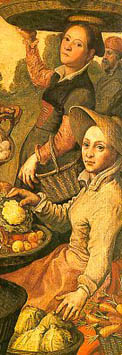
This jacket was, basically, a feminization of an item of clothing shown in many depictions of male peasants in Aertsen's and Beuckelaer's paintings. It was worn in conjunction with the common kirtle-and-laced-gown combination, and the two are shown in several paintings from 1564 to 1569.
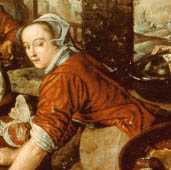
In this painting to the right,dated to 1570, a gown very similar to this jacket is shown: the front opening pinned back in the style of the laced gown's skirt, but, save for the length, virtually identical in cut. It was during this time that high-necked styles were gaining popularity in England and in other countries abroad; it was also in the 1570s that the women's doublet first appeared. This item of apparell so shocked the conservative writer Philip Stubbes that he described it as
"mans apparel is for all the world, and though this be a kinde of attire appropriate onely to man, yet they blush not to wear it..."
International Similarities in Lower-class Dress
There is evident proof that the clothing described was widely worn by Flemish workingwomen--but what about the rest of Europe? There is little data from France, Italy or England that can compare with the treasure trove of pictorial evidence left by Aertsen and Beuckelaer.

There is this sketch of London Gentlewomen, drawn by Flemish expatriate Lucas de Heere in 1570, which shows a London fishwife wearing a gown strikingly similar to those depicted in Flemish paintings: the bodice laces closed across an underdress, the sleeves are narrow and quite fitted, and a partlet with a ruff gathered to a collar is worn under a shoulder cape virtually identical to one shown in A sketch by Beuckelaer. An even more tantalizing link can be found in an even more unlikely place: Ireland.
(shinrone gown slide)
This drawing is of the famous late 16th century Irish "Shinrone Gown", discovered in a bog and now kept at the Museum of Ireland in Dublin. This gown is inexactly dated, and was discovered more than a thousand miles from Flanders. In many ways, however, it resembles greatly the gowns worn during the same time period on the continent. Kass McGann, a historic costume researcher specializing in Celtic dress, recently traveled to Ireland and conducted a thorough scrutinization of the gown, taking measurements and clarifying many of the mysteries surround its construction. Her article, "The Shinrone Gown: An Irish Dress for the Elizabethan Age" (listed in the bibliographic handout) contains construction and fabrication information which is useful to someone attempting to reconstruct Flemish workingwomen's dress.
The Shinrone gown has an open-fronted bodice with vertical front edges and a bottom section of the bodice which meets at the front center where it is sewn together--and a pleated skirt, with no open seams or edges, sewn all the way around the bottom of the bodice. This bodice design may have been used for the Flemish gowns mentioned above, with open-fronted bodices but no corresponding front opening in the skirt.
The bodice is partially lined, but in a curious fashion--the fabric of the bodice is quite a bit longer than the waist, and is doubled up to the inside to the level of the bust and tacked down. The center front openings are turned towards the inside and whipstitched, and the bottom edge is already finished--and strengthened as well. With the heavy skirts attached to it, a finished edge that wouldn't unravel or pull out of the seam would be a great help.

The front of the Shinrone bodice curves down to just under the bust, as several of the Flemish gowns portrayed do. In addition it has a flat-bottomed armscye, with back and front pieces forming an "arch" over the shoulder. In one of the few Flemish paintings which shows the back armhole of a gown (pictured to the right) it too has an arched shape--a flat bottom piece going around the side, sewn to a taller back piece which arches over the shoulder to meet the front. (It must be noted, however, that in Flemish paintings the front of the armscye appears to be curved in a more modern fashion.)
A contemporary traveler described Irish Dress thusly:
"They have straight bodyes [bodices], and long waists, but theyre bodyes come no closer but to the middle of the ribbe, the rest is supplyed with lacing, from the topp of their breasts, to the bottome of theyre plackett, the ordinary sort have only theyr smockes between, but the better sort have a silke scarfe about theyre neck, which they spread and pinne over theyre breasts. On the forepart of those bodyes they have a sett of broad silver buttons of goldsmiths worke sett round about."
This description, aside from the buttons, very closely matches that of lower class Flemish gowns of the 1560s and 1570s. In some of Beuckelaer's market scenes, a scarf is worn over the partlet and pinned together at the middle of the kirtle neckline.
On the whole, lower-class Flemish dress resembled the dress of the middle classes--to a point. More affluent women were shown wearing gowns which did not lace across the front, but rather fastened in front or laced closed in back. The fabrics and colors of the lower-classes would have been of cheaper quality, and practicality took precedence over fashion in some cases, as evinced by short skirts, straw hats, and clothing which allowed great ease of movement. Fashions for lower-class women during the 16th century were often years out of date, compared to upper-class styles; when talking about rural peasant fashions, this fashion-lag was sometimes decades. Some of Holbein's sketches drawn during the 1530s show women wearing gowns which lace closed across kirtles in a fashion reminiscent of the later Flemish style; though these sketches are not conclusive proof of the gowns' ancestry by any means, it is an area worth of further exploration.
Colors
An interesting side-note of my study was the wide variety of color in the clothing of the lower-classes: pink, fawn, russet, peach, gold, orange, blue, green, and several hues of similar colors were shown in these genre paintings, alongside the more mundane browns, tans and sadder colors that one would associate with poorer peasantry. All of these colors could be created with dyes which were cheap and available: woad, logwood, indigo, madder, weld, etc.

But another color--one I did not expect to see--was bright red. Common knowledge among costume historians has it that bright reds were worn exclusively by the upper classes in the mid-15th century, as such a brilliant red could only be obtained by using kermes, a very expensive foreign dyestuff unavailable to the lower classes and peasants. Yet this color is frequently shown in the paintings of Aertsen and Beuckelaer, worn by marketwomen, kitchen male and female servants and others. Sleeves are often red, as are kirtles; red hose, red jackets and doublets, and red hats are worn by men (I did not see any red gowns, however.)
There are several explanations for this disparity between painting and popular fact--the most obvious being that the colors used by the artist did not accurately reflect the palette of the lower-class Flemish wardrobe. Pigments and fabric dyes are two very different things, and there are many instances in which what you see isn't what they wore. Yet, considering the care with which every other aspect of these still life and genre paintings were portrayed--including the detailed and exacting use of color in still lifes and other paintings by these artists--this theory lacks the strength it might have in other cases.
Another explanation is that some of the fabric worn by women of this class originated with members of a higher class. It might have been given by employers to servants as part of their wages, as the provision of fabric for clothing was an essential part of the master-servant contract, or it might have come in the form of hand-me-downs or sale of used garments from upper to lower class, which were also common practices.
A third and more interesting possibility is that a brilliant red color was obtainable with more commonly affordable dyestuffs, such as madder, a cheap and widely used fabric dye. "Turkey red", a brilliant, crimson hue which originally came from India and which was by the 16th century common in the middle and near east, was derived from madder in conjunction with tin, soda, galls, oil, and a complex mordanting process. This color is a very, very bright red indeed; and, if produced from madder, may have been lower in price than similar kermes-dyed fabrics. The common belief that bright reds were not part of the lower-class wardrobe may take some re-thinking.
Practical Application
Upon hearing the lengthy catalogue of clothing worn by these women, one might think it would be bulky, confining and hot. To my surprise, I found this to be false. I had looked at the paintings and attributed the layering of woolen skirts and gowns to the "cool, damp and cloudy" nature of the Netherlands; it's easy to imagine that the weather in England and Northern Europe of the time wasn't as bright and sunny as it is today, and indeed Flemish weather is in general more rainy during much of the year than the American Mid-west. The "little ice-age" of this time period is often pointed to as another explanation for the heavier clothing seen in 16th century paintings.
The ensemble is, in fact, relatively cool--I have worn smock, kirtle, gown, linen and wool partlets and wool sleeves on a warm summer's day and been warm but not sweltering. The linen smock and kirtle wick away sweat and breathe wonderfully, and the open underarms and bodice front help to dissipate heat.
If it gets too hot, one can put the layered nature of the dress to good use: simply removing the woolen over-partlet can cool you down significantly. If you're still too hot, removing the woolen or linen sleeves can help even more
and takes less than a minute to accomplish. Rolling up smock sleeves, pinning back or tucking up the skirts of your gown and tucking the front of the kirtle into the bottom-most lace of your gown (if you are wearing a petticoat) can make the hottest day quite bearable. In fact, the linen partlet is a wonderful form of protection for "bodice burn", or the sun-burning of the upper chest which can occur when wearing historic dress of the 16th century for long periods of time.
If the weather cools, the woolen gown and a woolen kirtle worn underneath, with woolen sleeves and a woolen partlet,can keep you comfortably snug in 40 degree temperatures. The jacket which was sometimes worn over the gown and linen partlet can keep me warm in even lower temperatures. Flannel petticoats, a winter mainstay for women of the time, are an additional solution for damp, cold weather.
This outfit is also ideal for the "hard use" that working women put it to during the 16th century. The relatively short length of the smock, kirtle and skirt, combined with the decorative tucks and back-pinning of the outer skirt used by Flemish women, greatly reduce the possibility of tripping or tangling legs and other items in skirts. The rectangular apron, when tied firmly on, keeps the skirts from swinging about in front as well as protecting them from everyday grease and grime. The mobility of pinned-on sleeves and the lack of stiffened undergarments makes it possible to bend, stoop, twist, lift and reach without putting serious strain on any major part of the garment. For larger-bosomed women, the cut and fit of kirtle & gown provide comfortable and secure support.
This dress is also an ideal one for pregnant women, or for any significant weight gain or loss. The gown's open front can be laced tighter or looser as the body demands, and the kirtle underneath can be laced more loosely or tightly in the back as well, where the lacings won't be seen.
All of the hairstyles and headdresses described above (with the exception of the decorative Flemish hood) are exceedingly practical as well as decorative, and keep the hair neatly out of the way. I have worn a flemish caul from sun-up to sun-down and not once had my hair or the headwear come loose.
Jennifer Thompson has done further research into the construction of these Flemish Gowns. You can read her article A Working Woman's Dress Revisited, or check out Photographs of Flemish Gown Reconstructions
Pictography:
Aertsen, Pieter. "Peasant Feast", Kunsthistorisches Museum, Vienna 1552
Aertsen, Pieter. "Peasant Company", van den Bergh Museum, Antwerp 1556
Aertsen, Pieter. "Egg Dance", Rijksmuseum, Amsterdam
Aertsen, Pieter. "Crepe-Making Scene", Boymans-van-Beuningen Museum, Rotterdam 1560
Aertsen, Pieter. "Cook", Musee des Beaux Arts, Brussels
Aertsen, Pieter. "Christ with the Woman Taken in Adultery", Staedel Kunstinstitut, Frankfurt 1559
Aertsen, Pieter. "Old Peasant", National Museum, Budapest
Aertsen, Pieter. "Vegetable Seller", van de Vin Collection, Antwerp, 1567
Aertsen, Pieter. "Market Scene",Hallwyl Museum, Stockholm 1569
Aertsen, Pieter. "Market Scene", undated (1560s)
Aertsen, Pieter. "Market Scene with Ecce Homo", Alte Pinakothek, Munich (fragment) before 1552
Aertsen, Pieter. "Return from the Procession",Musee des Beaux Arts, Brussels
Aertsen, Pieter. "Poultry Vendors", 1563
Beuckelaer, Joachim. "Market Scene with Ecce Homo", Nationalmuseum, Stockholm 1565
Beuckelaer, Joachim. "Market Scene with Ecce Homo", Germanisches Museum, Nurnberg 1566
Beuckelaer, Joachim. "Market Scene with Ecce Homo", Schottenstiftes Collection, Vienna
Beuckelaer, Joachim. Beuckelaer, Joachim. "Market Scene with Ecce Homo II", Nationalmuseum, Stockholm 1570
Beuckelaer, Joachim. "Exotic Animal Vendor", Capodimonte Museum, Naples
Beuckelaer, Joachim. "Market Scene with Ecce Homo", Uffizi Gallery, Florence 1566
Beuckelaer, Joachim. "Mar ket Scene with the Miraculous Draught of Fishes", Macdonald Collection, Isle of Skye 1563
Beuckelaer, Joachim. "Making Waffles", 1565
Beuckelaer, Joachim. "Fish Market", Capodimonte Museum, Naples 1569
Beuckelaer, Joachim. "Market Scene with the Miraculous Draught of Fishes", Capodimonte Museum, Naples 1570
Beuckelaer, Joachim. "Market Woman w/ Fruit & Vegetables", van den Bergh Museum, Antwerp 1565
Beuckelaer, Joachim. "Market Scene", Wilhelmshohe, Kassel 1564
Beuckelaer, Joachim. "Kitchen Scene with Christ in the House of Martha & Mary", Rijksmuseum, Amsterdam 1565
Beuckelaer, Joachim. "Kitchen Scene with the Supper and Way to Emmaus", National Museum, Prague 1564
Beuckelaer, Joachim. "Peasant Company", Antwerp Museum
Beuckelaer, Joachim. "Peasant Festival", Hermitage, Leningrad
Beuckelaer, Joachim. "Seven Works of Charity", National Museum, Warsaw
Beuckelaer, Joachim. "Country Market", Capodimonte Museum, Naples. 1560s
Beuckelaer, Joachim. "Saints Peter & John Healing", Hermitage, Leningrad
De Heere, Lucas. "Sketch of London Gentlewomen", 1570
Bibliography
Moxey, Keith. Aertsen, Beuckelaer and Secular Painting in the Reformation. Garland Publishing, c. 1977
Ashelford, Jane. Visual History of 16th Century Costume.
Arnold, Janet. Queen Elizabeth's Wardrobe Unlock'd.
Adrosko, Rita. Natural Dyes and Home Dying
Carnegie, Gwyn. "To Make a Beautiful Color: Trade Dyes during the Elizabethan Era" Costume & Dressmaker
Holbein & the Court of King Henry the VIII
McGann, Kass. "The Shinrone Gown: An Irish Dress for the Elizabethan Age", Reconstructing History.
Home
 If you are interested in constructing an Flemish woman's ensemble based on the information in this paper, check out Constructing a 16th Century Flemish Ensemble.
If you are interested in constructing an Flemish woman's ensemble based on the information in this paper, check out Constructing a 16th Century Flemish Ensemble.
















 Lacking more concrete evidence, this is what I chose to reconstruct when making my outfit--a low-necked, sleeveless dress with no waist seam, fitted to the waist and flaring from there to the ankle.
Lacking more concrete evidence, this is what I chose to reconstruct when making my outfit--a low-necked, sleeveless dress with no waist seam, fitted to the waist and flaring from there to the ankle. Linen smocks were worn by all women, not merely those lower down the food chain. Their purpose was a utilitarian one: they provided an easy-to-clean layer between the body and outer garments, protecting the less easily-washable wool gowns, kirtles & petticoats from sweat and body oils.
Linen smocks were worn by all women, not merely those lower down the food chain. Their purpose was a utilitarian one: they provided an easy-to-clean layer between the body and outer garments, protecting the less easily-washable wool gowns, kirtles & petticoats from sweat and body oils.



 Older women are sometimes shown wearing a more traditional, unwired "flemish hood" reminiscent of those shown in the 1520s and 1530s.
Older women are sometimes shown wearing a more traditional, unwired "flemish hood" reminiscent of those shown in the 1520s and 1530s.




